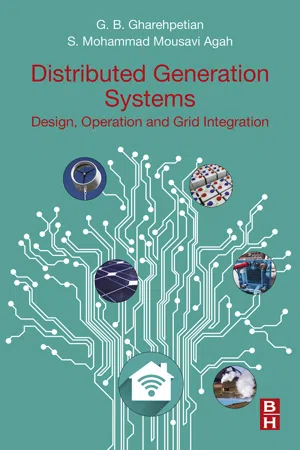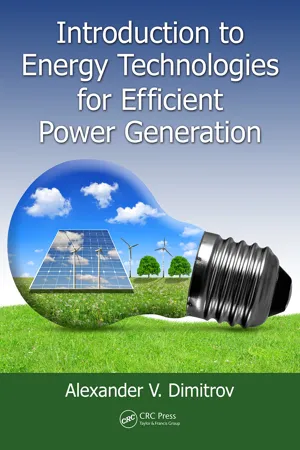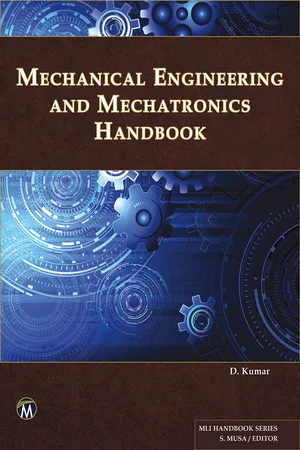Technology & Engineering
Turbine
A turbine is a device that converts the energy from a moving fluid (such as water, steam, or air) into mechanical energy. This mechanical energy is typically used to generate electricity or perform other types of work. Turbines are commonly used in power plants, aircraft engines, and other industrial applications due to their efficiency in converting energy from one form to another.
Written by Perlego with AI-assistance
Related key terms
Related key terms
1 of 4
Related key terms
1 of 3
4 Key excerpts on "Turbine"
- eBook - ePub
- D. Yogi Goswami, Frank Kreith, D. Yogi Goswami, Frank Kreith(Authors)
- 2017(Publication Date)
- CRC Press(Publisher)
12Hydraulic Turbines
Roger E.A. Arndt and Leonardo P. Chamorro CONTENTS 12.1 General Description 12.1.1 Typical Hydropower Installation 12.1.2 Turbine Classification 12.1.2.1 Impulse Turbines 12.1.2.2 Reaction Turbines 12.2 Principles of Operation 12.2.1 Power Available and Efficiency 12.2.2 Similitude and Scaling Formulae 12.3 Factors Involved in Selecting a Turbine 12.3.1 Performance Characteristics 12.3.1.1 Impulse Turbines 12.3.1.2 Reaction Turbines 12.3.1.3 Performance Comparison 12.3.2 Speed Regulation 12.3.3 Cavitation and Turbine Setting 12.4 Performance Evaluation 12.4.1 Model Tests 12.5 Numerical Simulations 12.6 Field Tests 12.7 Other Concepts: Hydrokinetic Turbines Defining Terms References Further InformationA hydraulic Turbine is a mechanical device that converts the potential energy associated with a difference in water elevation (head ) into mechanical work. Modern hydraulic Turbines are the result of many years of gradual development. Economic incentives have resulted in the development of very large units (exceeding 800 MW in capacity, i.e., two orders of magnitude larger than their wind counterparts) with efficiencies that are sometimes in excess of 95%.However, the emphasis on the design and manufacture of very large Turbines has shifted to the production of smaller units, especially in developed nations, where much of the potential for developing large base-load plants has been realized. At the same time, the sustained increase in the cost of energy has made many smaller sites economically feasible and has greatly expanded the market for smaller Turbines. The increased value of energy also justifies the cost of refurbishment and increasing the capacity of older facilities with modern runners having higher efficiency and greater capacity. The introduction of high-performance computational tools in the last decade has had considerable influence on the design of hydraulic systems, their operation, and control. - eBook - ePub
Distributed Generation Systems
Design, Operation and Grid Integration
- Gevork B. Gharehpetian, S. Mohammad Mousavi Agah(Authors)
- 2017(Publication Date)
- Butterworth-Heinemann(Publisher)
The Turbine is the heart of MTs because it plays the main role in electric power production and in single-shaft design, where a compressor and a generator are rotating with the Turbine. A Turbine is a rotary mechanical device, which is used to convert the energy of a working fluid to useful work. The working fluid contains potential energy and kinetic energy and the Turbine extracts energy by several physical principles.The main factors in choosing Turbines include manufacturing costs, cycle flow path, leakage problems, and stability of shaft. Axial and radial are two types of Turbine that are different in air path flow. In the radial Turbine the flow of working fluid is radial to the shaft. The axial types are used in heavy gas Turbines but radial types are more efficient in micro gas Turbines. The advantages of the use of radial Turbines in MTs are higher single-stage ratio, small volume, simple structure. and higher efficiency. Fig. 4.16 shows a radial Turbine that is coupled to a compressor.4.5.3 Combustor
Combustion means the act of burning, and the combustion process is a high-temperature chemical reaction between the fuel and oxygen in which heat is released.A combustion chamber is a part of an internal combustion engine in which fuel and compressed air are mixed and burned; the resulting high-temperature exhaust gas is used to drive the Turbine. The combustion chamber in agas Turbine is called a combustor, and a MT combustor has continuous operation unlike in a reciprocating engine. The combustion equation of the natural gas is given by [11 ]+ 4 O →C H4+ 2C O2H 2O + heat(4.12)Because air contains 78% nitrogen and 22% oxygen, there are four molecules of nitrogen for every molecule of oxygen in air. So, the complete combustion reaction of methane can be written as follows [11 ]:→+ 2C H4O 2+ 4N 2Methane + Air+ 8C O2N 2+ 2H 2O + heatCarbon dioxide + Nitrogen + Water + Heat(4.13)The combustor's purpose is to produce enough energy for the system. T main factors in a combustor's design include complete combustion, lower pressure losses, smaller size, and lower environmental emissions. There are three main types of combustor: annular type, can type, and can-annular type, which are briefly described below. - Alexander V. Dimitrov(Author)
- 2017(Publication Date)
- CRC Press(Publisher)
2Conversion of Thermal Energy into Mechanical Work (Thermal Engines)Energy-related (power) technologies may be treated as a combination of engineering-technical methods of energy and work conversion employed to facilitate human life. They are divided into two main groups. The first group comprises technologies of heat conversion into another type of energy (mechanical, electrical, electromagnetic, etc.) while the second one comprises technologies of heat transfer, accumulation, and regeneration. Each thermal technology discussed herein will be illustrated by specific physical schemes and devices. We shall consider them in the following order:•Technologies of mechanical work performance (so called thermomechanical technologies) •Technologies of generation of electrical energy (thermoelectric technologies) •Technologies of heat transformation (regeneration and recuperation) •Technologies of heat transfer and collection (transfer and accumulation) •Technologies creating comfortable environment (air conditioning and ventilation)Thus, we will treat a certain technology as an object of study of respective scientific-applied research fields, on one hand, and we will follow the teaching programs on “Power engineering,” “Transport management” and “General mechanical engineering,” on the other hand.2.1 Evolution of Engine TechnologiesAs is known from physics, energy conversion follows a natural course, that is, energy of motion of macro- and microbodies (popular as mechanical energy) is converted into heat by mechanisms that are studied by tribology (including dry, semi-dry, viscous, or turbulent friction). No opposite transformation is observed in nature. Heat conversion into energy needed for the operation of machines and mechanisms was an impossible task for primitive people as well as for those living in slave-holding* and feudal†- eBook - ePub
- D. Kumar, Sarhan M. Susa(Authors)
- 2022(Publication Date)
- Mercury Learning and Information(Publisher)
static machines wherein the static pressure is developed by a displacement action rather than by a velocity or kinetic energy change. During certain stages of operation, the fluid is fully contained within solid boundaries and it cannot escape except through leakage. A positive displacement machine can be reciprocating (i.e., petrol, diesel, and steam engines; reciprocating pumps and compressors) or a rotary (gear and screw pumps, root blowers, and vane 199 compressors) device while a turbomachine is always a rotary machine. Further, in a positive displacement machine, an interaction between the moving part and the fluid involves a change in the volume and/or displacement of the fluid. When the fluid volume increases, there is a transfer of energy from the fluid to the mechanical system. Conversely, when the fluid volume diminishes, energy is transferred to the fluid system.Compared to the positive displacement machine, a turbomachine unit has the advantages of few balancing problems due to the absence of reciprocating and rubbing parts, exceptionally low consumption of lubricating oil, no conversion loss of power from rectilinear motion into rotary motion, and high reliability.6.1. HYDRAULIC TurbineSHydraulic Turbines are required to transform fluid energy into usable mechanical energy as efficiently as possible. Further, depending on the site, the available fluid energy may vary in its quantum of potential and kinetic energy. Accordingly, a suitable type of Turbine needs to be selected to perform the required job.Depending upon the basic operating principle, hydraulic Turbines are categorized into impulse and reaction Turbines depending on whether the pressure head available is fully or partially converted into kinetic energy in the nozzle.● Impulse Turbine wherein the available hydraulic energy is first converted into kinetic energy by means of an efficient nozzle. The high-velocity jet issuing from the nozzle then strikes a series of suitably shaped buckets fixed around the rim of a wheel (Figure 6.1
Index pages curate the most relevant extracts from our library of academic textbooks. They’ve been created using an in-house natural language model (NLM), each adding context and meaning to key research topics.
Explore more topic indexes
Explore more topic indexes
1 of 6
Explore more topic indexes
1 of 4



